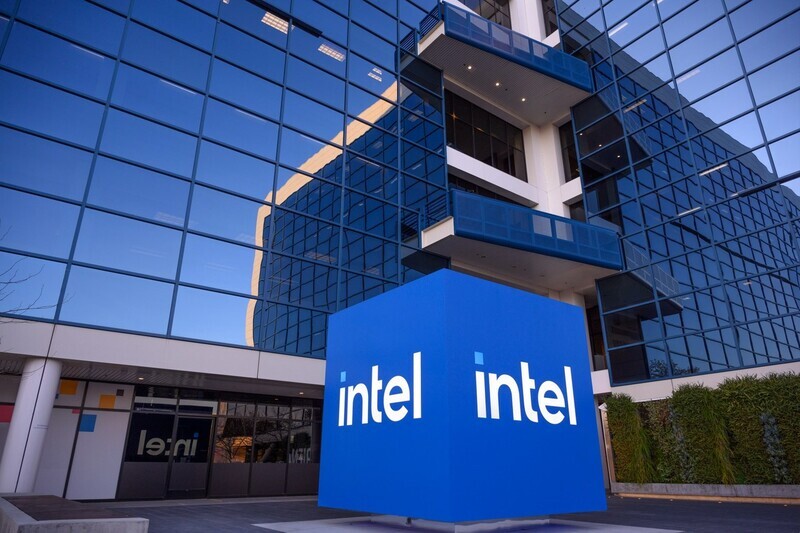hankyoreh
Links to other country sites 다른 나라 사이트 링크
Intel’s latest move could shake up the world’s chip foundry industry

Intel announced plans to have its foundry division operate independently and funnel all its chip production to that division. By strengthening its semiconductor manufacturing division, the company seems determined to shake up the chip sector and reclaim its old crown.
If Intel gives internal chip business to its foundry division, those sales alone could propel the division above Samsung Electronics’ foundry division, analysts say. That will add a third player to the global foundry market, which has been dominated by Samsung Electronics and Taiwan Semiconductor Manufacturing Company (TSMC).
Intel told investors in a call on Wednesday that its foundry division will shift to a customer-supplier relationship with other parts of the company in the first quarter of 2024 as part of its plan to make the division globally competitive. That will mainly involve separating its foundry division from its fabless (chip design) division.
Under the new model, the foundry division will fulfill chip manufacturing orders for the fabless division. In terms of accounting, Intel’s in-house chip production will now be recorded as revenue for the foundry division.
Samsung Electronics has also been running its foundry as a separate business with its own profit-and-loss statement since 2017.
Intel launched its foundry division in 2021, promising to return to its “glory days.” Intel and Microsoft were the twin pillars of the personal computer industry in the 1990s, but since the advent of mobile devices, fabless companies like Qualcomm and Arm have taken the lead.
As Intel pondered how to boost revenue amid a slump in PC sales, the US government’s policy of expanding the semiconductor supply chain seems to have motivated Intel to go all out on semiconductor production.
But three years into that effort, Intel’s impact remains negligible. Intel took in US$800 million in orders from other companies last year, failing to reach the US$1 billion mark.
According to Intel Chief Financial Officer David Zinsner, Intel’s foundry division will enter the top ranks of the world’s foundries with more than US$20 billion in revenue when internal orders are included. That’s comparable to the US$20.8 billion that Samsung Electronics’ foundry division is estimated to have earned last year.
Currently, Intel produces 80% of its own chips, while 20% are made by other companies.
Jason Grebe, a corporate vice president and general manager at Intel, mentioned inefficiencies related to time and cost that occur in the process of producing chips in-house. Separating the fabless and foundry divisions could increase production efficiency and save as much as US$3 billion in costs, he said, explaining that Intel’s internal chip output alone could make the foundry division the second largest in the industry.
Intel has been boosting facility investment in countries around the world to strengthen production capacity. The company announced on Sunday that it will be investing US$25 billion in building a semiconductor factory near Kiryat Gat, Israel. And last week, it released plans to spend US$4.6 billion on a semiconductor post-processing facility in Wrocław, Poland.
The chipmaker is also seeking to build cutting-edge semiconductor factories in Magdeburg, Germany, and Leixlip, Ireland, and to set up semiconductor R&D centers in Paris, France, and Barcelona, Spain.
Industry sources say the jury is still out on whether Intel’s foundry business will be a success. The foundry division hasn’t been around long enough to gain a technological edge, and it’s also uncertain whether Intel can secure big clients that would have a corresponding impact on revenue.
“Intel has the technology needed to make chips related to areas of strength such as personal computers and servers, but it’s uncertain whether it’s able to make top-of-the-line semiconductors in the mobile sector as well. Since clients have few reasons to take on the risks involved in switching foundries, Intel’s foundry division is unlikely to be profitable in the short term,” said a source in the South Korean foundry industry who spoke on condition of anonymity.
Market fears caused Intel’s stock price to tumble 6% to US$32.90 by the close of trading on Wednesday.
By Ock Kee-won, staff reporter
Please direct questions or comments to [english@hani.co.kr]

Editorial・opinion
![[Column] Tariffs on China: Trump was dumb, Biden dumber [Column] Tariffs on China: Trump was dumb, Biden dumber](https://flexible.img.hani.co.kr/flexible/normal/500/300/imgdb/original/2024/0520/191716191153918.jpg) [Column] Tariffs on China: Trump was dumb, Biden dumber
[Column] Tariffs on China: Trump was dumb, Biden dumber![[Column] What if Seoul took reunification by force off the table? [Column] What if Seoul took reunification by force off the table?](https://flexible.img.hani.co.kr/flexible/normal/500/300/imgdb/original/2024/0520/3017161928630494.jpg) [Column] What if Seoul took reunification by force off the table?
[Column] What if Seoul took reunification by force off the table?- [Editorial] Intensifying US-China rivalry means Seoul must address uncertainty with Beijing sooner than later
- [Column] When ‘fairness’ means hate and violence
- [Editorial] Yoon must stop abusing authority to shield himself from investigation
- [Column] US troop withdrawal from Korea could be the Acheson Line all over
- [Column] How to win back readers who’ve turned to YouTube for news
- [Column] Welcome to the president’s pity party
- [Editorial] Korea must respond firmly to Japan’s attempt to usurp Line
- [Editorial] Transfers of prosecutors investigating Korea’s first lady send chilling message
Most viewed articles
- 1Xi, Putin ‘oppose acts of military intimidation’ against N. Korea by US in joint statement
- 2For new generation of Chinese artists, discontent is disobedience
- 3[Editorial] Transfers of prosecutors investigating Korea’s first lady send chilling message
- 4[Column] When ‘fairness’ means hate and violence
- 5[Editorial] Intensifying US-China rivalry means Seoul must address uncertainty with Beijing sooner t
- 6How K-pop broke the internet — and broke into the US market
- 7[Exclusive] Unearthed memo suggests Gwangju Uprising missing may have been cremated
- 8‘Shot, stabbed, piled on a truck’: Mystery of missing dead at Gwangju Prison
- 9Naver to acquire Canada’s Wattpad to fuel its IP ambitions
- 10AI, robots won’t free us from work - they’ll make our jobs worse